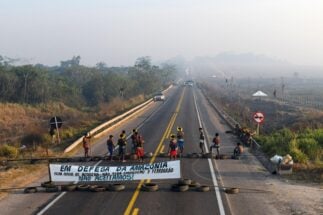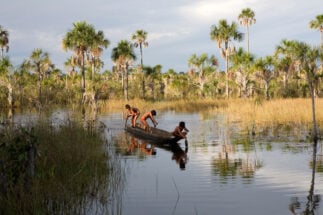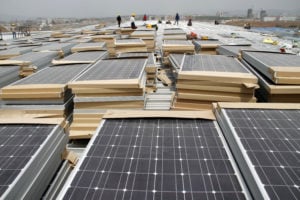In the 2010s, China became a major investor in Brazil’s railways, financing billion-dollar infrastructure projects to facilitate the export of agricultural and mineral products. While these initiatives serve important economic interests, they also generate negative social and environmental impacts in threatened biomes such as the Amazon and the Cerrado.
In order to face some of these challenges, over the years Chinese players have learned to operate in Brazil’s complex business environment, adapting to the country’s legal, political, and environmental frameworks. For their part, Brazilian actors have also learned important lessons about how to take better advantage of the large resources contributed by Chinese companies.
US$66 billion
China's investment in Brazil in the decade up to 2020
According a recent Brazil-China Business Council report, Chinese companies have already invested around US$66 billion in Brazilian territory. Most of this flowed to the electric power sector (48%) and oil and gas (28%). Infrastructure works, such as railways, account for 5% of the total. However, even this small percentage contributes to filling Brazil’s huge infrastructure gap. Since the crisis of the developmentalist model in the 1980s, the country has invested only 0.15% of its yearly average share of GDP in its rail network, a network of only 30,000 kilometres, which carries only 15% of the country’s goods. China, by contrast, has around 146,000km of railroad, which carries almost half of its freight.

These limitations present a series of challenges for agribusiness and mining. These sectors demand more railroads, largely to lower the cost of transporting their production in the north and midwest regions to ports in the northeast and Amazon basin, from where they are exported to international markets, including China, the top buyer of Brazilian commodities. Chinese railway construction companies, such as China Communications Construction Company (CCCC) and China Railways Construction Corporation, have shown interest in financing such projects.
China learns the rules of the game
Initially, these companies proposed to the Brazilian government the creation of binational state-owned companies that would be responsible for carrying out the works. However, Brazilian authorities resisted this model. Since the privatisations and liberal reforms of the 1990s, different Brazilian governments have prioritised the execution of infrastructure projects through public concessions, awarded through auctions. The competitive format allows the state to analyse several proposals and choose the most advantageous, without relying on a single partner or investor. In its most recent form, such bidding is organised by the Investment Partnerships Program (PPI), which the Brazilian government created in order to facilitate contracts between the state and the private sector.
As Chinese companies become involved in projects with high socio-environmental risks, such as Ferrogrão, there will be increased pressure for greater dialogue with Brazilian actors
Chinese companies have adapted and learned the rules of the game, becoming extremely competitive in these auctions. For example, they have hired Brazilian law firms and consultants to better understand relevant regulatory frameworks. In particular, CCCC bought the engineering and construction contractor Concremat, which has long experience in public tenders, and began to build a specialised team.
Ferrogrão and other infrastructure projects
PPI has auctioned or started the concession process for several railways in recent years. These include the Pará Railroad, which CCCC will build to connect the city of Marabá to the port of Barcarena, creating a corridor for the export of iron ore from the Carajás complex, the largest iron ore mine in the world and one that has been active for more than five decades. There are also expectations that the West-East Integration Railroad, which will connect the Cerrado’s agricultural production belt to the ports of Bahia, will begin operations.
ILO's Convention 169
Brazil has signed the International Labour Organization's Convention 169, which guarantees indigenous peoples affected by infrastructure projects the right to free, prior and informed consent. The convention was ratified in 2002 and entered into forced the following year
The most ambitious project is Ferrogrão, which has not yet been auctioned. Almost one thousand kilometres long, the railroad seeks to connect Mato Grosso’s agricultural production hubs to river ports on the Tapajós River in Pará. It will run parallel to the BR-163 highway and is defended by agribusiness companies as a landmark project for both enabling and accelerating the export of commodities such as soy and beef.
However, Ferrogrão entails strong socio-environmental impacts. The railway, which would cross the Cerrado and the Amazon, would cut through indigenous lands and environmental preservation areas. Local communities, political parties, social movements and the Federal Public Ministry (MPF, in its Portuguese acronym) have questioned several aspects of the project in court. The potential forced displacement of traditional communities is one major concern. On some occasions, the MPF has been victorious, ensuring the temporary suspension of the works. The private sector has also criticised the expected costs of the railroad, which may be significantly higher than Brazilian government estimates.
Lessons for China and Brazil
For the Chinese, investments in the Amazon railways have offered lessons on the need to adapt to the regulatory framework, the Brazilian political system and the local business culture.
For Brazilians, these lessons relate to the importance of laws, regulatory agencies and oversight bodies to define and monitor rules and risks related to large infrastructure projects. There are significant gaps in their regulation, such as the absence of clear mechanisms for compliance with the International Labour Organization’s Convention 169, which guarantees indigenous peoples impacted by public works projects the right to free, prior and informed consultation.

Another important learning experience can be found in the dynamism of Brazilian civil society. Despite a very hostile political climate for environmental campaigners, civil society groups have been able to act, exert pressure, and seek the support of public control and oversight agencies. As Chinese companies become involved in projects with high socio-environmental risks, such as Ferrogrão, there will be increased pressure for greater dialogue with Brazilian actors responsible for protecting the environment, at the state and non-governmental levels.
Lessons learned from the case of Ferrogrão are not exclusive to investments in railroads and can also be applied to other large infrastructure projects in the electric power, oil and gas sectors. They provide important insights on China’s increasing significance as an investor in Brazil amid greater pressure nationwide and globally for the private sector to adopt more sustainable environmental, climate, social and governance practices.








